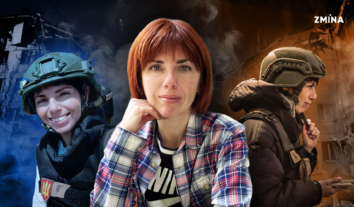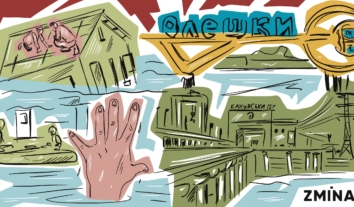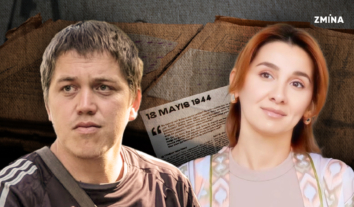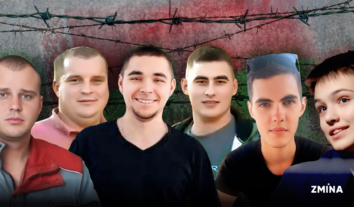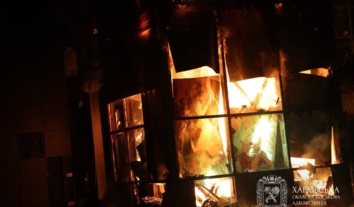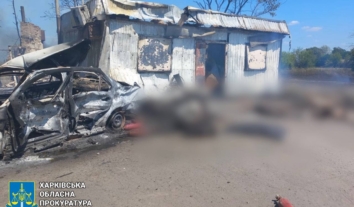‘I came for a cross to put on grave of murdered girl and was hit in teeth with buttstock’: reportage on Russian war crimes in Chernihiv region’s village
The local media labeled the village of Shestovytsia, 19 km of Chernihiv city, as Chernihiv region’s Chornobayivka [a village in Kherson region where Russian troops and weapons have been destroyed constantly by Ukrainian troops]. Russian soldiers entered the village on February 28 and placed hundreds of pieces of military equipment in its streets, at farms and private kitchen gardens. At the same time, the Ukrainian army destroyed about 40% of Russian weapons by targeting the clusters of Russian equipment in different parts of the village at least four times and burning them to ashes.
Shestovytsia was under occupation until March 31. And although the locals say that the Russian military did not treat them “cruelly”, they committed many war crimes in the village: looted, shot the cars of people who were trying to evacuate, killed several men, kidnapped a civilian, threw a grenade into the basement where civilians were sheltering.
At the end of June, a ZMINA journalist visited Shestovytsia together with the Educational Human Rights House Chernihiv experts who document the Russian war crimes of the Russians within Ukraine 5 AM Coalition. The article tells about life in the village during the occupation.
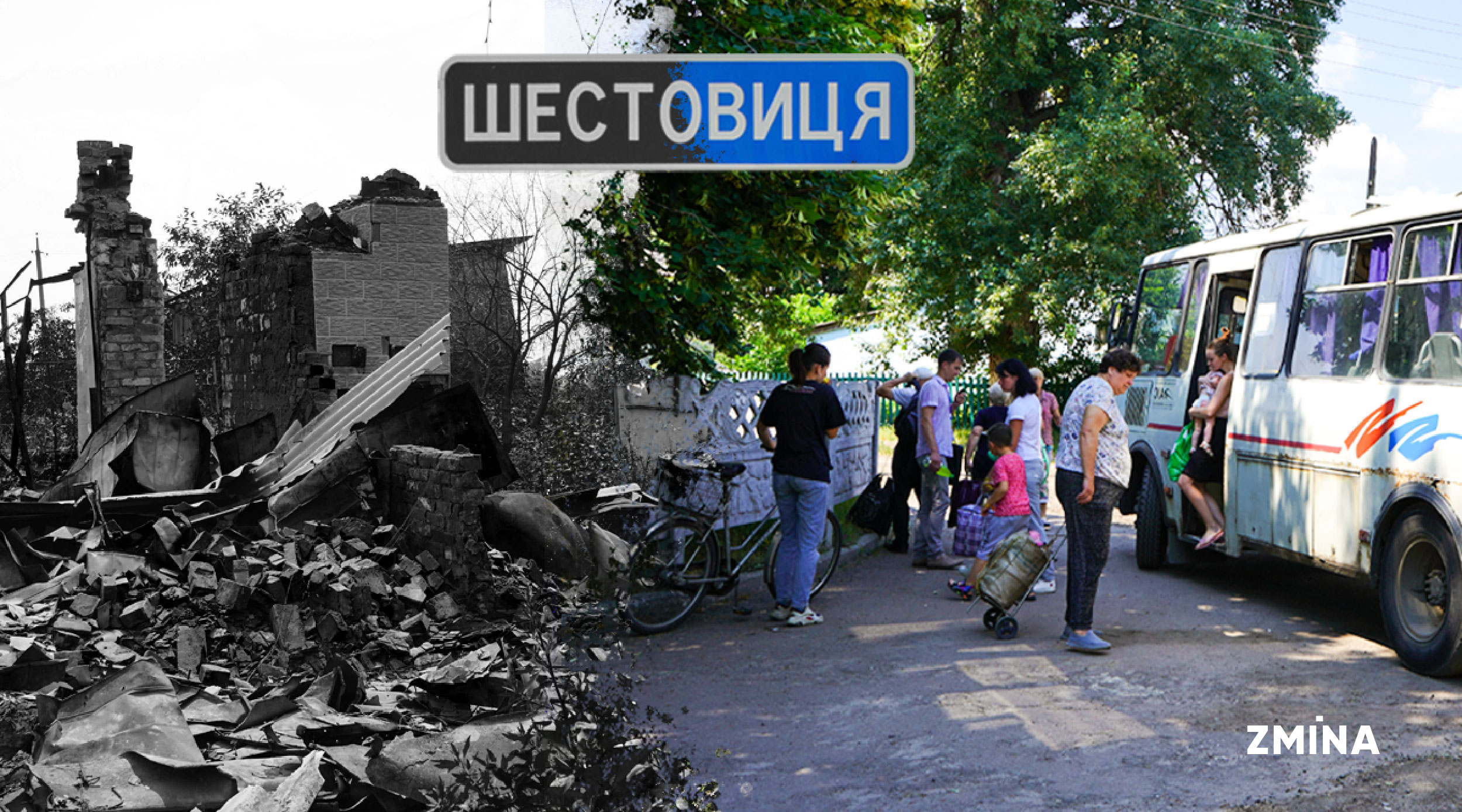
‘At least 600 units of Russian equipment arrived on the first day’
Shestovytsia is a village with history. The first written record of it back to 1523 describes a military fortification of the times of Kyivan Rus in Horodok tract.
The traumatic events closest to our time that Shestovytsia had to endure include the Holodomor of 1932-1933, carried out by the USSR government (the village was then subjected to “black board” terror ">і ), and the German-fascist occupation of 1941-1943.
In 2022, the village again found itself under occupation during another attempt by the country, whose president and officials consider it to be the successor of the USSR, to destroy the Ukrainian people.
On February 28, hundreds of units of Russian equipment drove into Shestovytsia from Mykhaylo-Kotsiubynske village. Before that, the local territorial defense units had managed to leave the village at night.
Shestovytsia has a favorable geographical location: E95 road runs past it, leading to Kyiv via the road bridge over the Desna River. Fierce battles took place on the crossing at some point during World War II.
Today, a roadblock near the village announces with several handwritten notices: “No bridge.” Five months ago, the Ukrainian military blew it up to stop the advance of enemy troops.
Shestovytsia is a small village with slightly more than 500 residents before the full-scale war. The vast majority of roads in the village are unpaved, buildings are single-story, and almost every house has a kitchen garden.
Peremohy Street leads from the highway towards Shestovytsa, ending in the forest. The only two grocery stores are located there, and the Shestovytsia village council can be found nearby.
The council premises are well-kept as a typical administrative building in a small village: flowers are planted in front of the facade, the front door is painted pink, the windows are new, metal-plastic, the building is decorated with siding elements.
A memorial plaque at the village council building honors the memory of Pylyp Morachevskyi, a native of Shestovytsia, a writer, a teacher, and a scholar. In 1860, he translated the New Testament into Ukrainian, but it was banned by the Valuev Circular ">і , so the translation was published only in 1906.
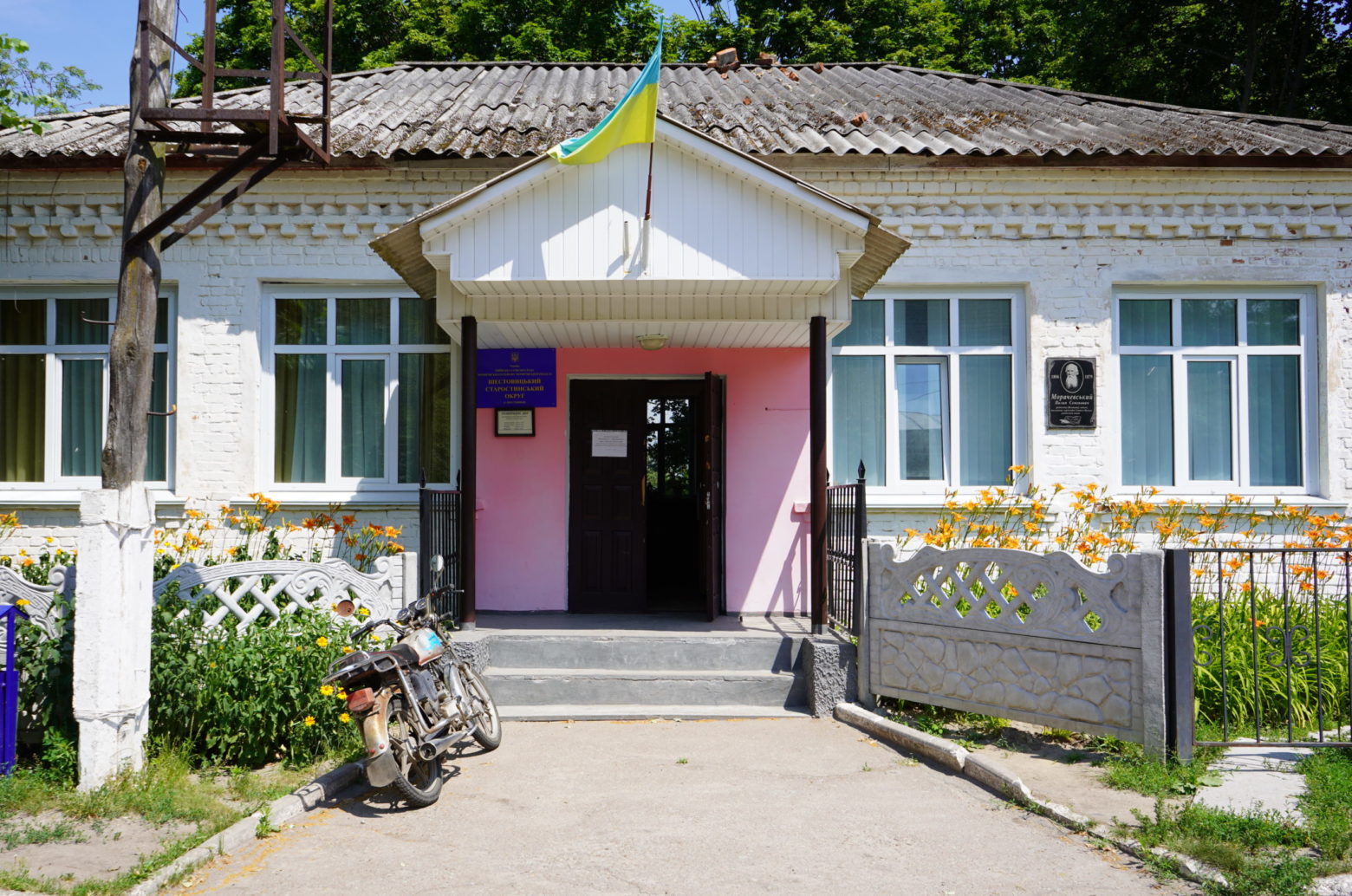
Serhiy Medvedev, the head of the village, is sitting in a small corridor of the village council building. Only a huge hole in the place of the shot lock on the door points to the Russians who were here.
When the Russian military entered the premises of the village council on February 28 in the afternoon, there was no one there – people had time to hide.
“The only thing is, I worried that I didn’t take the files of a military registration and enlistment office. But they did not break that safe. The other two were broken, but there was nothing special in them,” Medvedev says.
He recalls coming to the village council on April 1, after the village was liberated, and seeing everything white inside:
“The Russians filled everything with a powder fire extinguisher. A printer was missing. We had disinfectants and their soldiers probably drank them. They nailed shut all the doors.”
On the first day, Medvedev says, at least 600 units of Russian weapons and military equipment arrived in the village: tanks, armored personnel vehicles, infantry fighting vehicles, Tigr infantry vehicles, UAZ and KamAZ trucks, Smerch and Uragan MLRS, self-propelled howitzers, as well as at least 18 KrAZ trucks for the construction of pontoon crossings. The Russians blocked the streets of Shestovytsia with military equipment, broke fences, and drove into private kitchen gardens.
“They had their headquarters somewhere near Mykhaylo-Kotsiubynske. The vehicles loaded with fuel and ammunition constantly drove from there. And the equipment kept arriving in columns. Some of them were taken to the crossing towards Yahidne and Ivanivka, but our troops were hitting the crossings,” says the village headman. The Russian military still managed to redeploy several hundred weapons and their carriers across the Desna River. Locals counted.
Medvedev told us about the crimes of the Russian military in a matter-of-fact way and somewhat tiredly as he has repeated that many times to Ukrainian law enforcement officers, representatives of international organizations, and journalists.
Four local civilians were killed in Shestovytsia during the occupation. The first victim – Viktor Sadovyi – was shot by a sniper when the man tried to leave the village on a bicycle.
The body of another man, Serhiy Pastushok, a Crimean who had bought a house in Shestovytsia after 2014 and was helping the local territorial defense forces with food from February 24, was found in a Chernihiv morgue at the beginning of June. The corpse was brought there from the road near the village of Zarichne, a part of Chernihiv. Apparently, the man also came under fire while driving to the city to buy food.
Two more people were killed on March 15. Together with several fellow villagers, they tried to evacuate from Shestovytsia by three cars. They were driving towards the nearby Kyinka. The Russians opened fire on them. Ihor Yanchuk died on the spot as he got a bullet in his head. The woman and her daughter who were traveling with him managed to break the window of the car and escape into the forest and later reached Chernihiv.
A 22-year-old girl, who also tried to leave, was wounded in the stomach. A man from another car took her back to Shestovytsia. He and his family were lucky to survive, but his child suffered a concussion.
In the village, the girl was taken first to relatives, and then to a Russian nurse.
“He said: ‘I can’t do anything.’ She was conscious and later died,” the village headman recalls.
One of Shestovytsia residents is considered missing. According to locals, a man named Oleksandr passed the information on the movement of Russian equipment to the Ukrainian army. Russian soldiers and FSB officers were looking for him in the village. The villagers believe that Oleksandr was killed but his body has been never found.
After the village had been liberated, the bodies of several more murdered people – non-locals – were found on the outskirts. A man from the neighboring village of Mazhuhivka was shot by the Russians in the forest. Nearby, at a garbage dump, the Russians killed two men from Desnianka, a village 24km of Shestovytsia. The police “unearthed” the body of another one at an agricultural enterprise.
‘The two stores were broken into on the first day’
Since the beginning of the full-scale invasion, some Shestovytsia residents have left the village. During the occupation, some of those who stayed moved to relatives or neighbors living in the streets without Russian equipment placed.
At the beginning of March, the electricity, gas, and water supplies were cut off in the village.
The headman of Shestovytsia says that Russian soldiers moved into all vacant houses:
“At first, they got accommodated in the houses along the entire perimeter of the village. Their equipment with ammunition and fuel tanks stood at Sadova and Kolektyvna streets. The Russians told the residents to flee. When the troops were withdrawing, they burned several houses.”
Medvedev notes that 100 of 420 buildings in Shestovytsia were destroyed or damaged during the occupation. According to the locals, the Russians evicted three families from the houses they needed for military purposes.
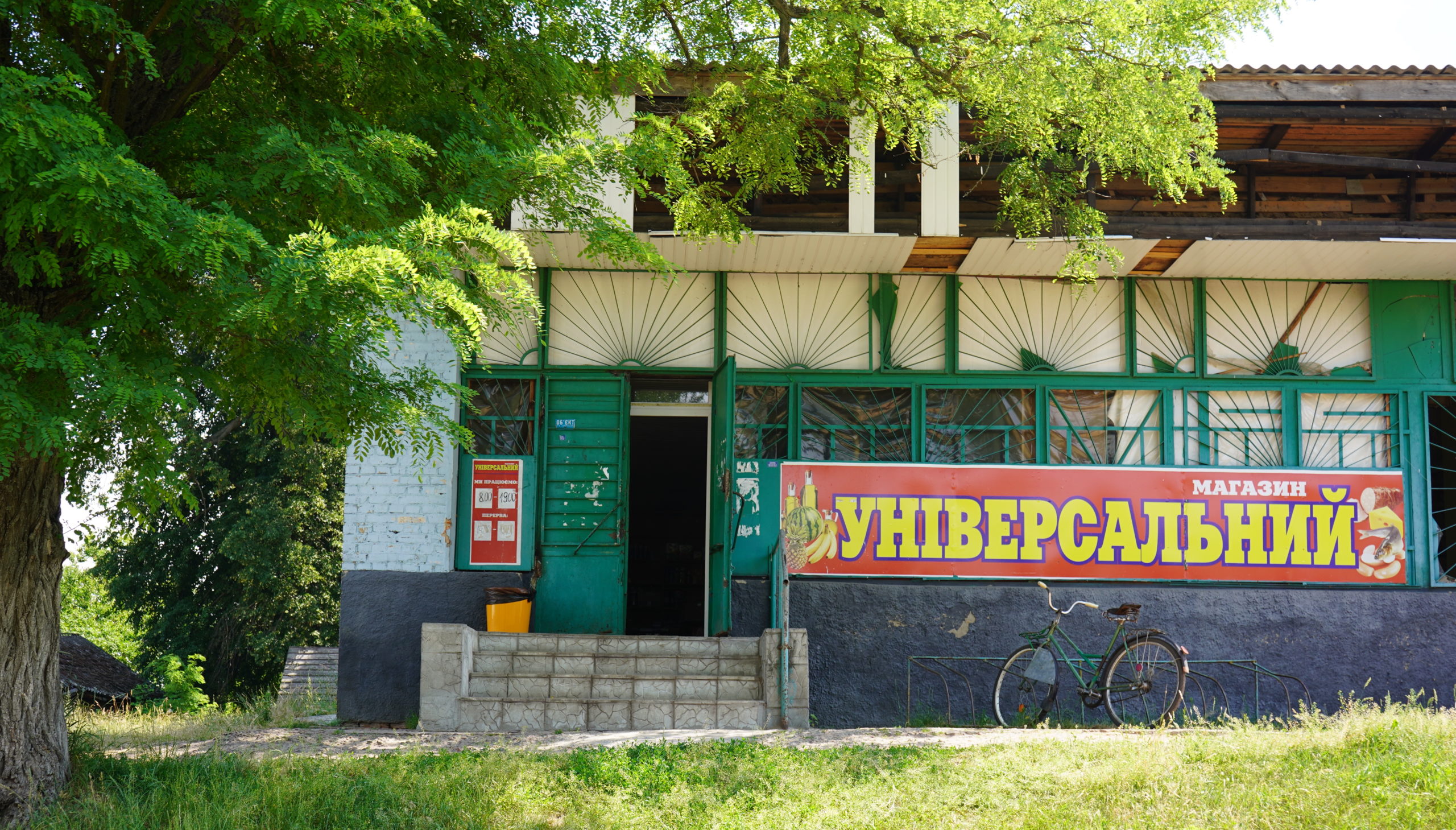
The village headman talks about the looting of Russian soldiers as if it was something ordinary:
“The two stores were broken into on the first day. Things were taken out of houses: chainsaws, brushcutters, microwave ovens, electric kettles, TVs. People were afraid and hid generators. But mostly the military asked for tobacco and vodka. A quad bike, a car, and several iPhones were stolen from one wealthy man. And a gold chain was taken from a child but it was returned later. The car also stayed in the village – the soldiers just cut the wheels.”
Shovels and tools were also taken from the villagers, which can perhaps be explained by military necessity.
Russian soldiers broke windows and stole musical equipment in the Shestovytsia House of Culture. They entered through the front door, which they had blown up first, says the village headman:
“They just beat the new plastic windows for no reason. They stole two new speakers, a mixer, and microphones.”
Locals were allowed to move around the village on foot and only to get water:
“The Russians went around and asked: ‘Where are your authorities? Let’s agree on water.’ They drained the wells down to the sand. Then they connected a generator to a well pump at a mushroom enterprise“.
The village experienced food and water shortages.
On March 10, local women began to go on bicycles to Kyinka to get humanitarian aid. Before that, on March 8, the Russians were struck in Kolektyvna Street and the soldiers moved nearer to the forest. But you can’t bring much on a bicycle. The Russian military banned men from walking around the village.
The village headman and his family were hiding in his parents’ house. He says that the Russians were not looking for him, although they came to their place like every house in the village in search of Ukrainian soldiers.
Medvedev describes the experience of communication with Russian soldiers as different:
“On the 3rd or 4th day of the occupation, six people came to our yard. At first, they wore balaclavas and then came without them. There were Tuvans, Chuvash people, 18-20 years old. I asked them: ‘What are you doing? Children are dying, civilians are dying, where are you shooting at? Do you have a family? What would you do if you were us? Would you defend yourselves?’ They said: ‘We would defend ourselves.’ I replied: ‘And we defend ourselves. Do you want to go home?’ They answered: ‘Yes, we do.’ I said: ‘Then go home, why don’t you go?’ ‘Our troops will shoot us,’ they answered.”
‘One of them knocked again, he brought two packages of his rations, saying: ‘For kids.’ Then they ate everything at our place’
The month that people spent in the cellars of houses make itself felt and locals eagerly spend time outside. It’s summer. People work in kitchen gardens, even if just small patches of land were not destroyed by the Russian equipment. Young people occasionally ride a motorcycle around the village.
Around the corner from the village council building, opposite a local store, three elderly men set up their observation post, comfortably seated on stools in the shade of a fragrant linden tree.
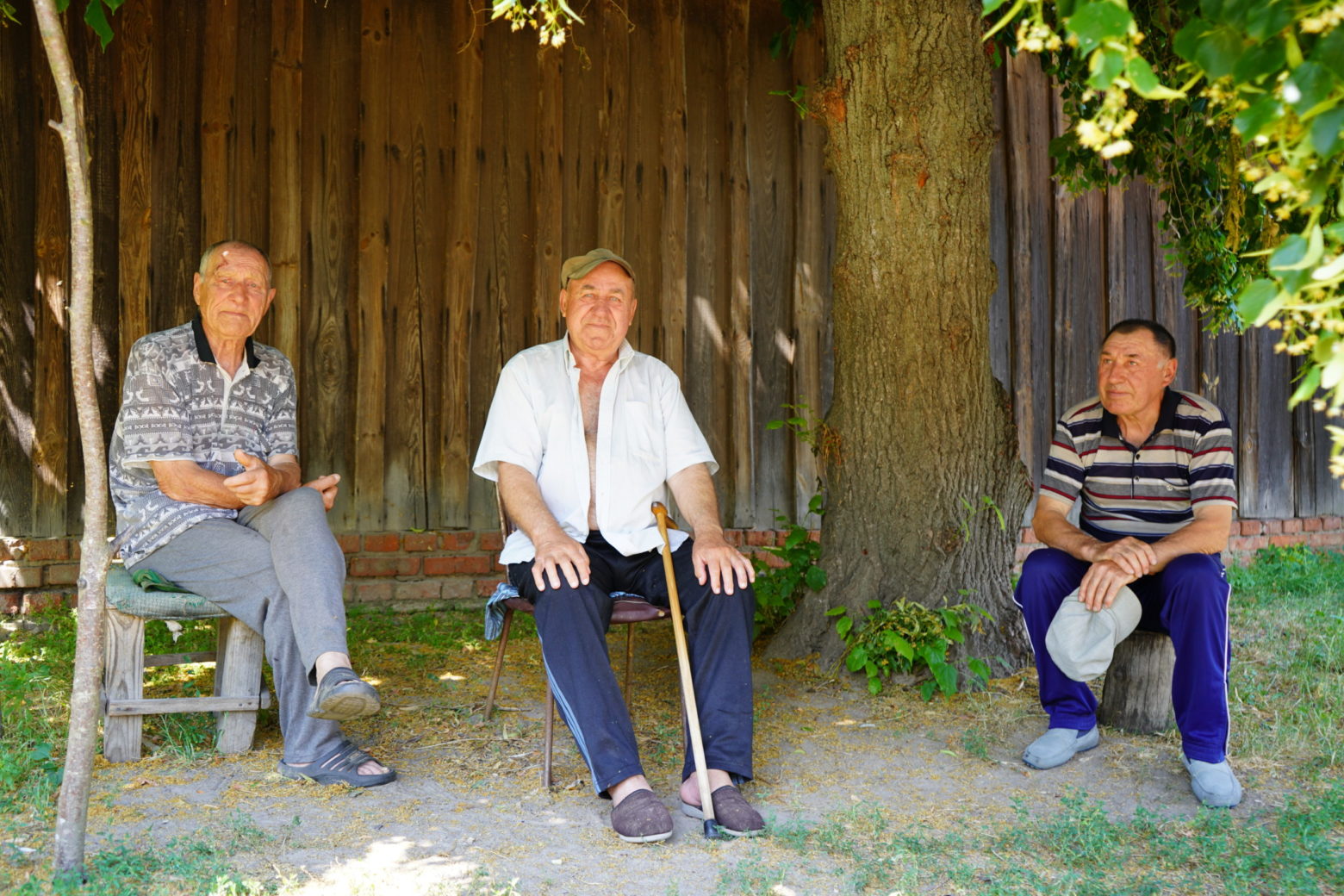 Oleksandr in the center
Oleksandr in the centerOne of them, Oleksandr, willingly tells us how he lived in a cellar with 12 other people.
He recalls four Russian soldiers coming down to them.
“One narrow-eyed comes to us and shouts: ‘Bath-house! Bath-house!’ Then he asked for shoes. My son opened a barn for him and said: ‘Choose.’ The soldier looked carefully and took the slippers which had already come apart. And the other said: ‘What city we are in? You have electricity, water, paved roads’,” Oleksandr humorously imitates the Russian pronunciation.
The soldiers noticed his son’s phone and ordered him to give it:
“And his contacts were simple: uncle, brother. They returned the phone. They told us: ‘Stay here.’ And they left. Then one of them knocked again: he brought two packages of his rations: ‘For kids.’ Then they ate all our potatoes, they ate everything, they took away the bedclothes and blankets.”
Almost every local says that the Russian military took blankets from people.
Oleksandr remembers the experience with a smile, but at some point he becomes serious:
“When they were bombed, it was an indescribable horror. When they were leaving the village… A tank with a 6-meter barrel, and they were sitting on it and smiling.”
The man’s friends nod their heads gloomily.
‘Soldiers brought my son-in-law into a house. He was bleeding, he covered my daughter with himself’
Elderly women and mothers with children get off an old bus at a stop at the crossroads near the village council, returning from elsewhere near Shestovytsia.
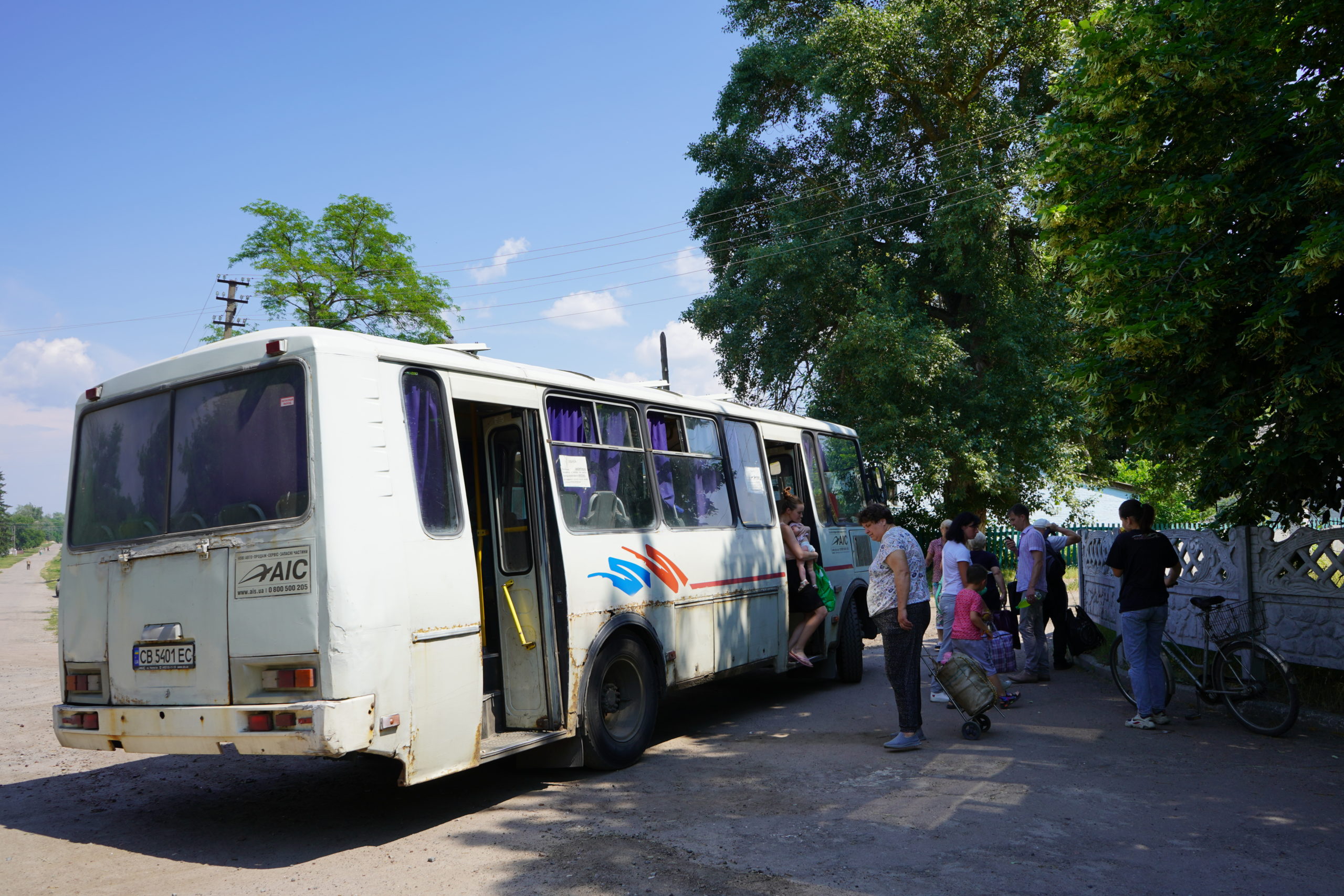
Some of them go towards Shkilna Street. Valentyna and her husband live here, in No. 9. Now their daughter and son-in-law Serhiy also live with them. They stayed together during the occupation. The younger couple, however, spent nights in the basement of a neighboring empty house.
Valentyna’s 50-year-old daughter has a disability, the woman says:
“They are from Chernihiv, but they live on the top floor of an apartment block. That’s why they came here because she can’t go down and up when there’s an air raid siren.”
It should have been safer for the couple. However, on February 28, Russian soldiers threw a grenade into the basement of the building where they were hiding.
Valentyna tells about this incident as her son-in-law and daughter have a rest. She recalls hearing machine gun fire near the house. And then there was an explosion:
“I hear my daughter coming and shouting: ‘Mommy, open the door.’ The soldiers brought the son-in-law into the house. He was bleeding as he covered my daughter with his body. Their doctor came, put in an IV, gave painkillers. The Russians told us: ‘We will make a corridor, call an ambulance.’ We called twice, but our troops didn’t let it in.”
Serhiy did not receive proper medical care until the village was liberated. His wife treated him. The man lost a lot of blood, had severed tendons. Valentyna’s daughter took part of the debris from his body with her own hands, as well as from hers, some of them remained. Serhiy lost a lot of weight, one of his legs got swollen. The man used to work at construction sites but now is unlikely to have a job due to his injuries.
The soldiers assured the family that they did not know if there were people in the basement, and if they spoke up, they would not be “touched”. But the daughter told Valentyna that the couple kept silent because they were afraid of being shot dead after coming out.
According to Valentyna, it is clear that the military knew that there were people in the basement.
“Before that, they were at our place and said: ‘Two people came to you.’ They started looking around, but they were not in the house. They were spotted leaving our place and going to the basement,” the woman recalls.
‘600 hryvnias were lying under the cigarettes, they took them and a bottle of cognac, calling that a ‘cleanup’
Kolektyvna Street is located two streets away from Shkilna Street – both lead through the fields towards the village of Mykhaylo-Kotsiubynske. At the beginning of Kolektyvna Street, almost nothing says that dozens of units of Russian equipment were completely destroyed here not so long ago. The houses in this part of the street are intact, although mostly empty and a bit neglected.
Some locals have already returned to their houses, few stayed here during the occupation.
A couple living in one of the houses is repairing the fence destroyed by Russian soldiers when a tank and three self-propelled howitzers drove into the garden. A neighbor helps them.
“One runs in and asks: ‘Have we come to Cherkasy?’ a local resident recalls the Russians coming to the village. She continues: ‘Their commander was a Crimean, 49 years old. We asked him why he was taking part in this, and he said: ‘I will either be shot there, or I will die here.’ But there was no such endless looting thanks to him. Let Andriy tell the story, he was thrown into the pit.”
Andriy, 50, has no particular desire to recall:
“Well, they interrogated me: ‘Where did you serve?’, they beat me on the hands, threw me into a pit,” he begins to tell, but anger takes over him: “Fuck them.”
But he continues, not saying a word about pit though. Andriy recalls the case when a girl died of a wound in the stomach while trying to leave the village. He went to the house of culture to take a cross and a funeral wreath:
“They saw me, I drove a cart. They came and shouted: ‘Leave a cross, bitch!’ I wondered how I should bury her. One of them said: ‘Let him take it.’ They hit me in the teeth with buttstock, but I was lucky to escape.”
Andriy continues:
“They took away buckets of water, and there were children with us in a cellar. I couldn’t stand it once and said: ‘Leave it to children.’ They beat me at home. They kept coming into the house and shouting: ‘We want to eat!’” The man spits.
Andriy had collected all the shells left by the Russians in the kitchen garden and hid them in the garage until, after the third call to the Ministry of Internal Affairs, they were taken away by the relevant services.
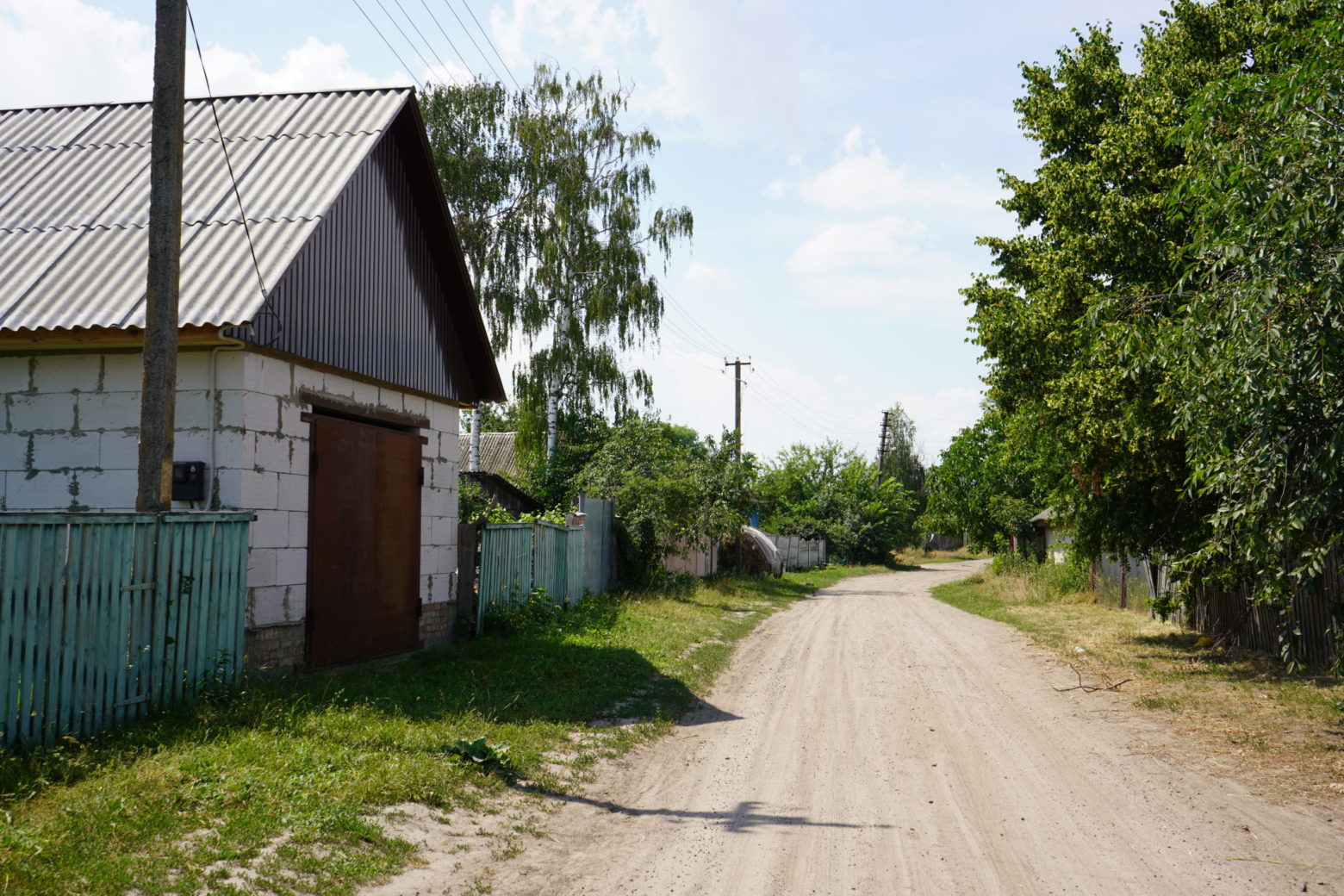
The couple’s neighbor, who helps them fix the fence, lives a few houses away. A self-propelled howitzer, which the Russians used to fire on the surrounding localities, was stationed in his yard.
He recalls the episode when the military came to search his house.
“600 hryvnias were lying under the cigarettes. They took them and a bottle of cognac, calling it a ‘cleanup’,” the resident of Shestovytsia smiles, “Everything was turned upside down in the house, I was standing at the point of a machine gun.”
A man calls his wife from a house so that she tells us about the occupation. The woman says that eight people with children and grandchildren were hiding in the basement.
“We were sitting in basement, coming to house, then returning to basement again. We did not contact anyone. A guard was walking around. We had to feed chickens and we wondered whether we would be able to slip through or not. They didn’t take food from us, but they took rabbits, chickens, and pigs from other people. We were not treated cruelly; we were addressed politely. They wrote “People” on the fence and hung red ribbons.”
“We made repairs but had no time to live in – there is no house anymore”
The couple’s house is one of the last almost completely survived in Kolektyvna Street. There are only burnt stones, smashed remains of walls, pieces of fittings, and fragments of Russian ammunition a few dozen meters away. The trees around are black, and the ground is scorched.
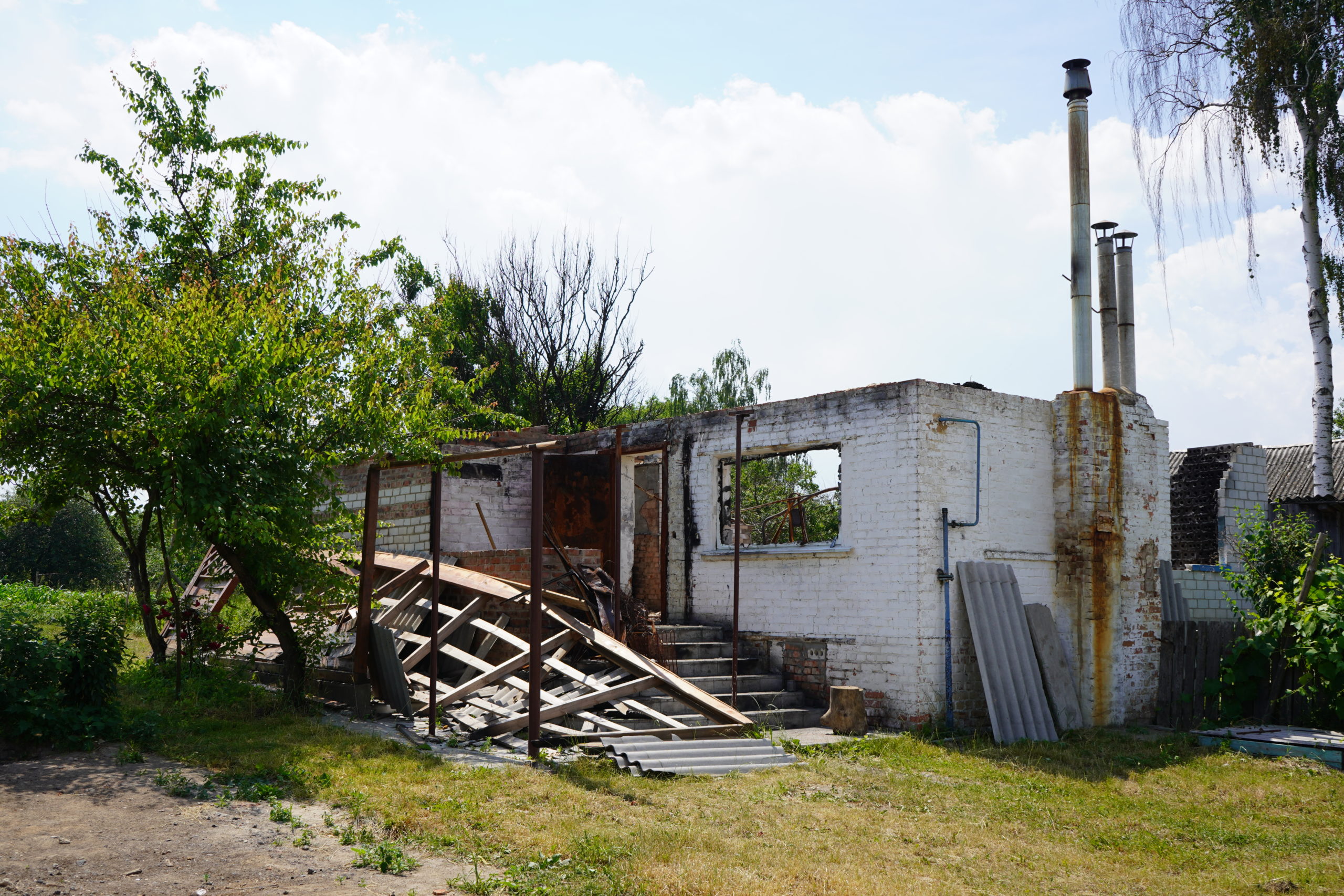
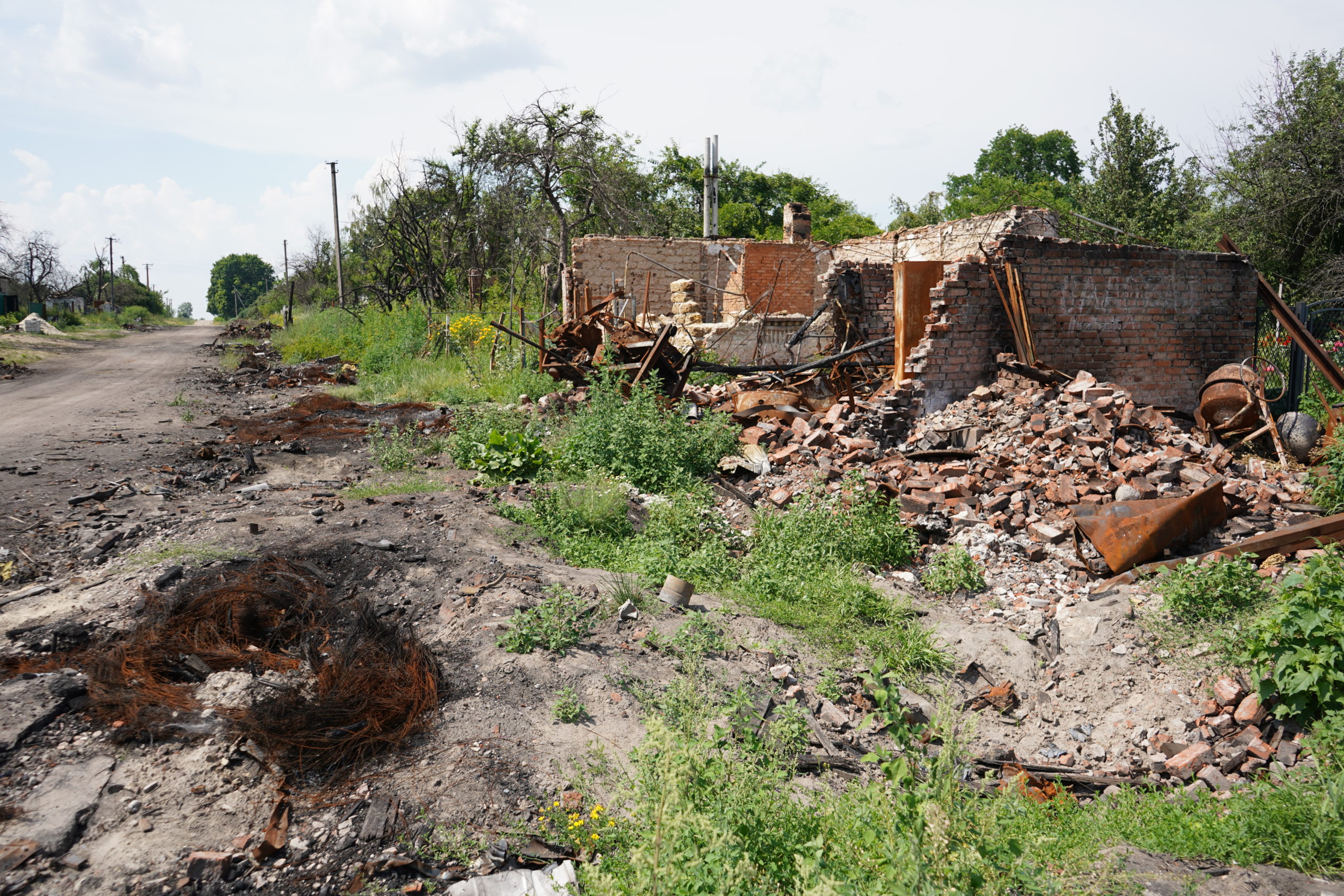
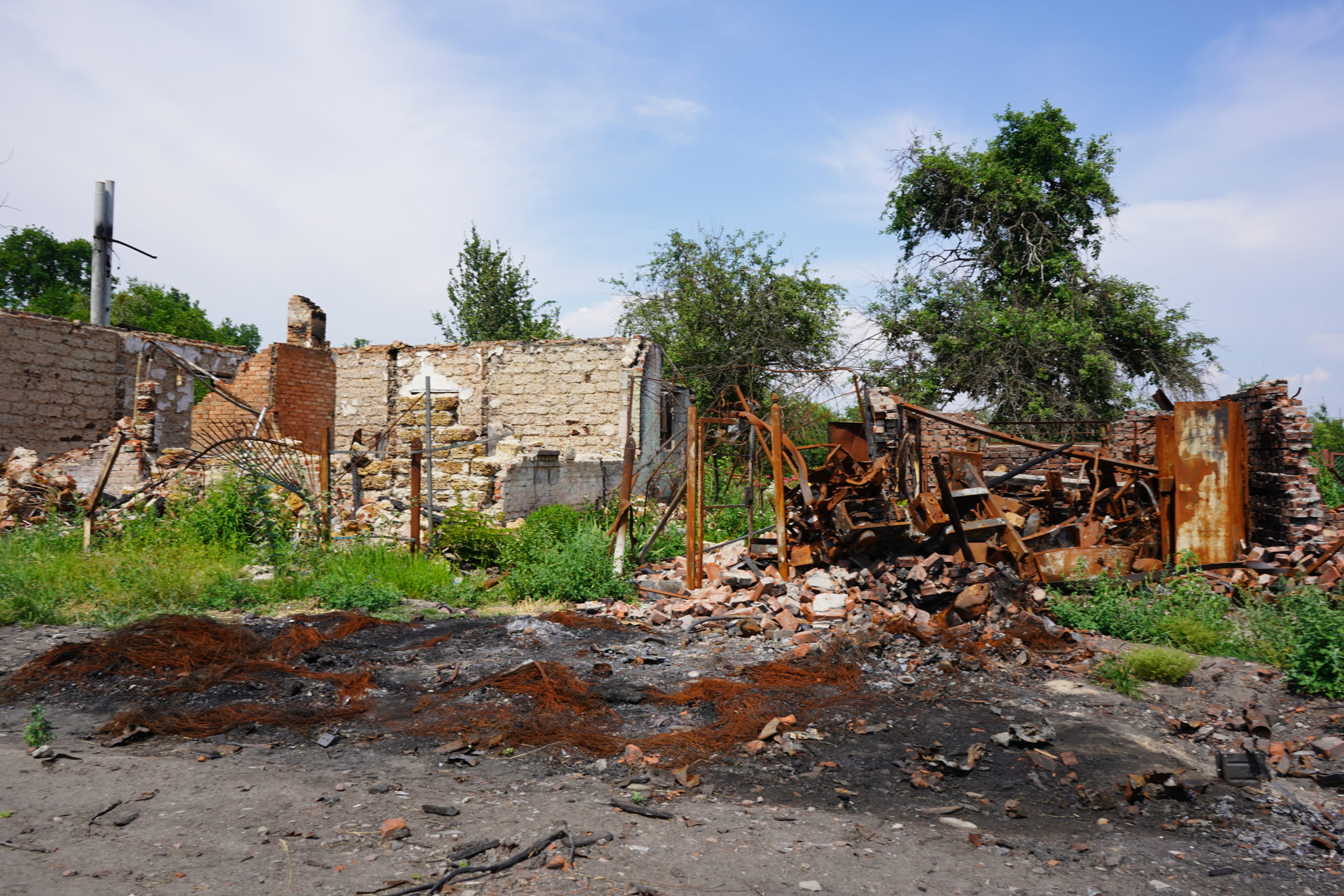






Valentyna, a local resident, sits next to her destroyed house. All that remained of the fence was the gate, riddled with debris. The extension behind is all in cracks.
“We had no time to live in it, we made a major overhaul last year. We redid everything: floor, walls. There is nothing now,” the woman laments monotonously.
She shows on her phone photos of broken Russian equipment and unexploded shells that were taken out by State Emergency Service rescuers.
“When our troops started shooting, the Russians went down to a basement with us and asked: ‘Can we go with you?’ And what will I say to them seeing their machine gun? Then one of them says: ‘Let’s flee, my car is over there, the shells are going to explode,” the woman recalls the moment when she and her family left the house at the beginning of the occupation. They “moved” to another street.
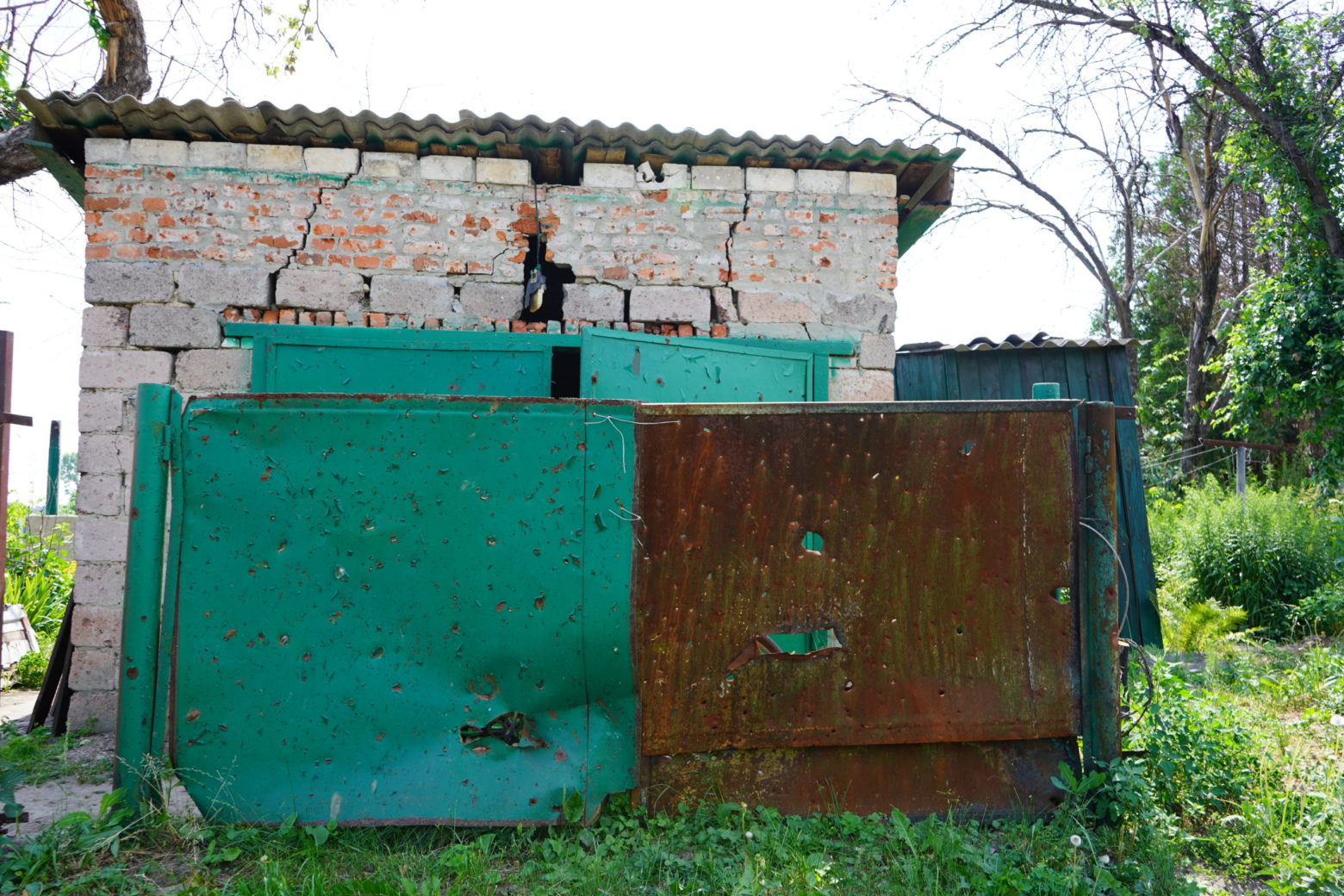
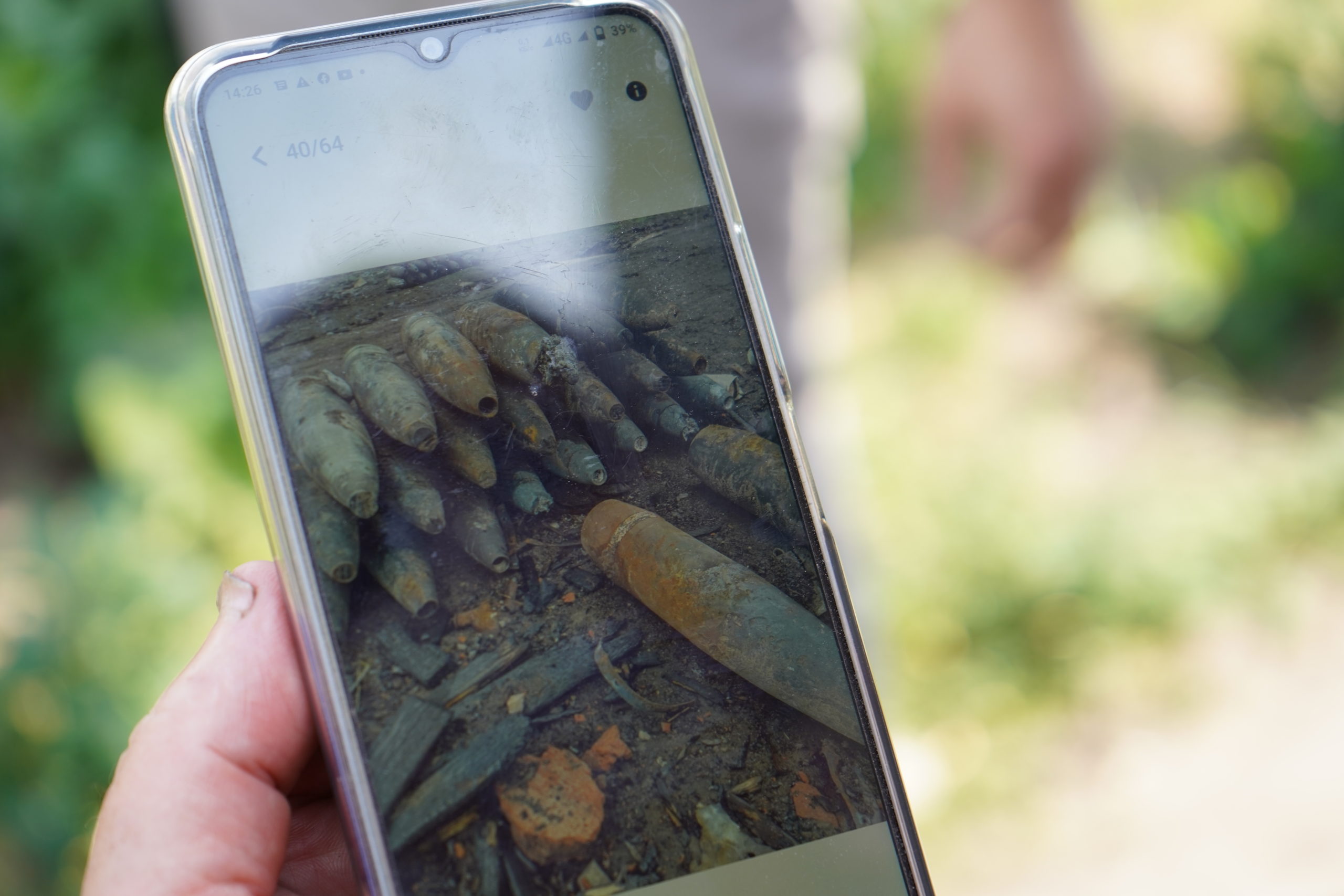
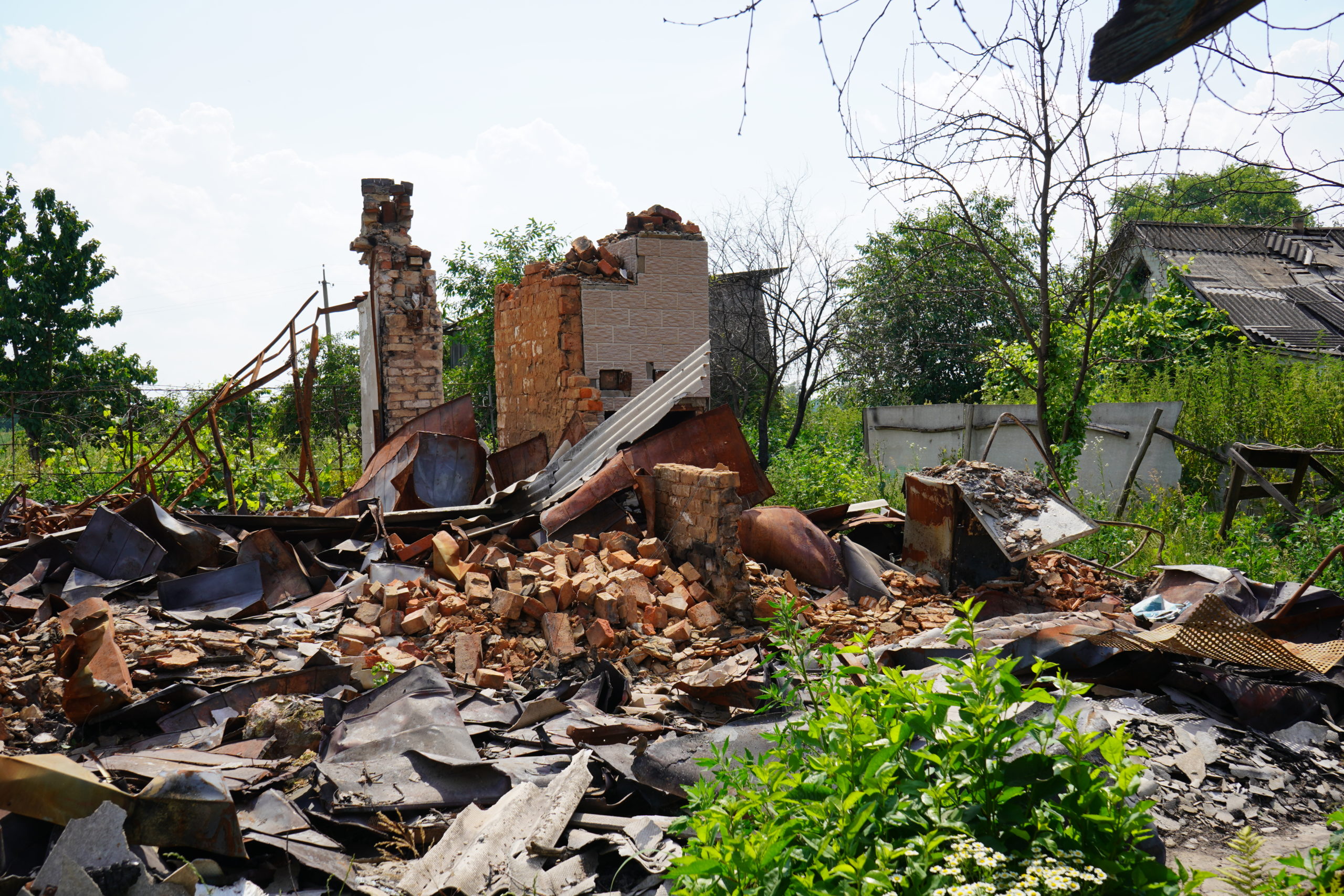



After the Russian military equipment had been destroyed in Kolektyvna Street, they were redeployed to the forest and made dugouts. However, part of the Russian troops remained on a farm nearby until it was hit by the Armed Forces of Ukraine.
‘If there had been an order, we would have had Bucha here’
Serhiy Luhyna, co-owner of “Lan” agricultural enterprise, says that the Russian military set up a command post here. When they came to the farm, the man was at work.
“They saw me wearing these pants and asked: ‘Are you a military man? Are you a spotter? If they hit us, I’ll shoot you,” Serhii points to his khaki pants and continues, “They didn’t have any information. As they say, they carried out combat reconnaissance. They combed the territory. They had bulging eyes, they understood that they were going to die.”
The man managed to leave the enterprise unharmed.
“My brothers came to the farm later. The command was from Donetsk. Their general said that there was an order not to touch the civilians, but if he gave another, everyone would be shot. And I kind of think that if a different order had been given, it would have been Bucha here. They strictly obey the command,” Serhiy says.
He says that the soldiers occupied every corner of the enterprise. The man shows one of the places where they slept – boards piled on top of each other served as their beds. There are still packages from Russian dry rations and stolen Ukrainian pate, a portable heater, and bottles of vodka. Soldiers drank a lot of alcohol. Farm workers threw collected glass containers into a huge pile not far from the hangar.
The piles of burned auto parts and damaged cars with wires sticking out are scattered around the farm’s territory. At the same time, a few months after the occupation, the premises of the farm and the hangar were already renovated noticeably.
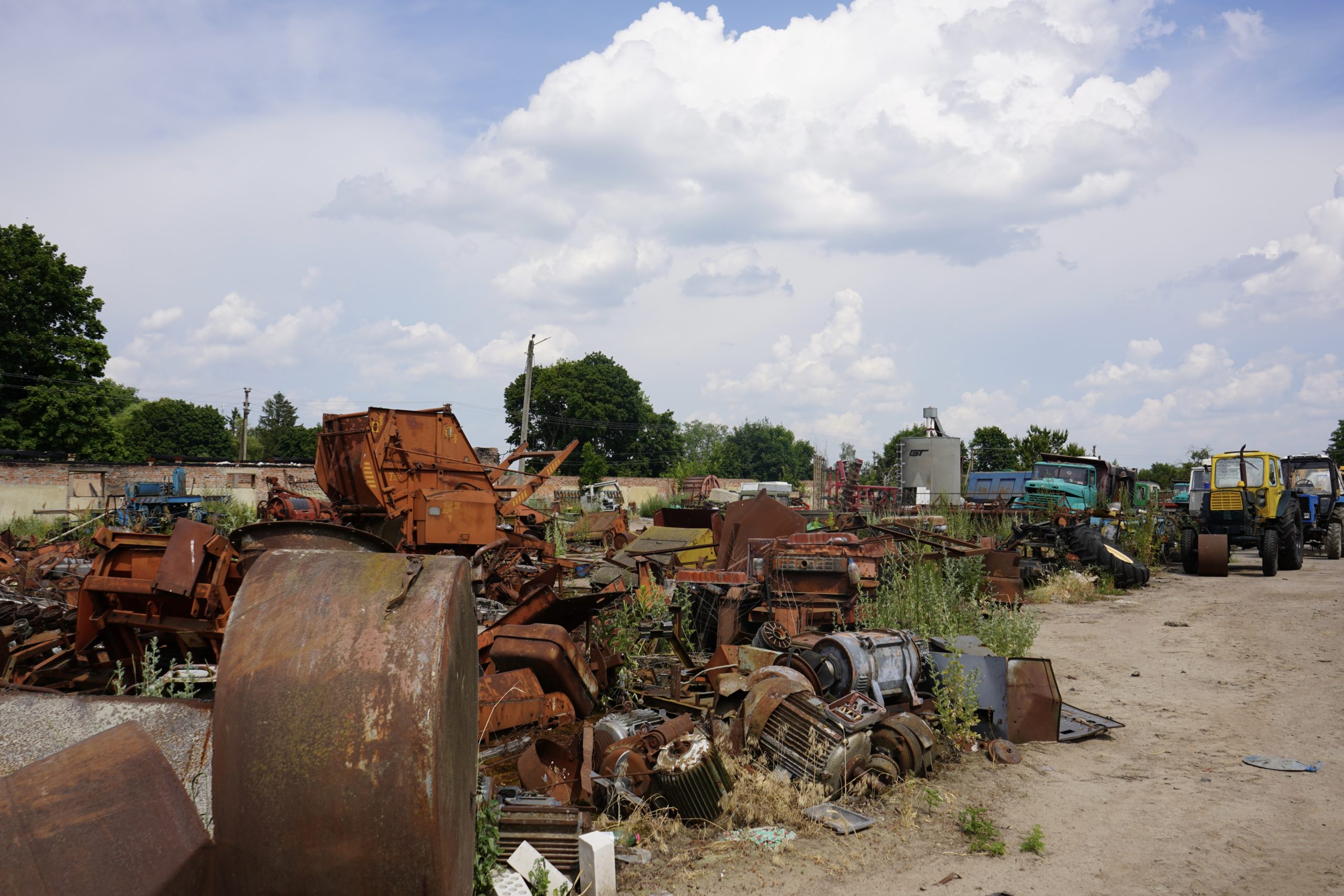
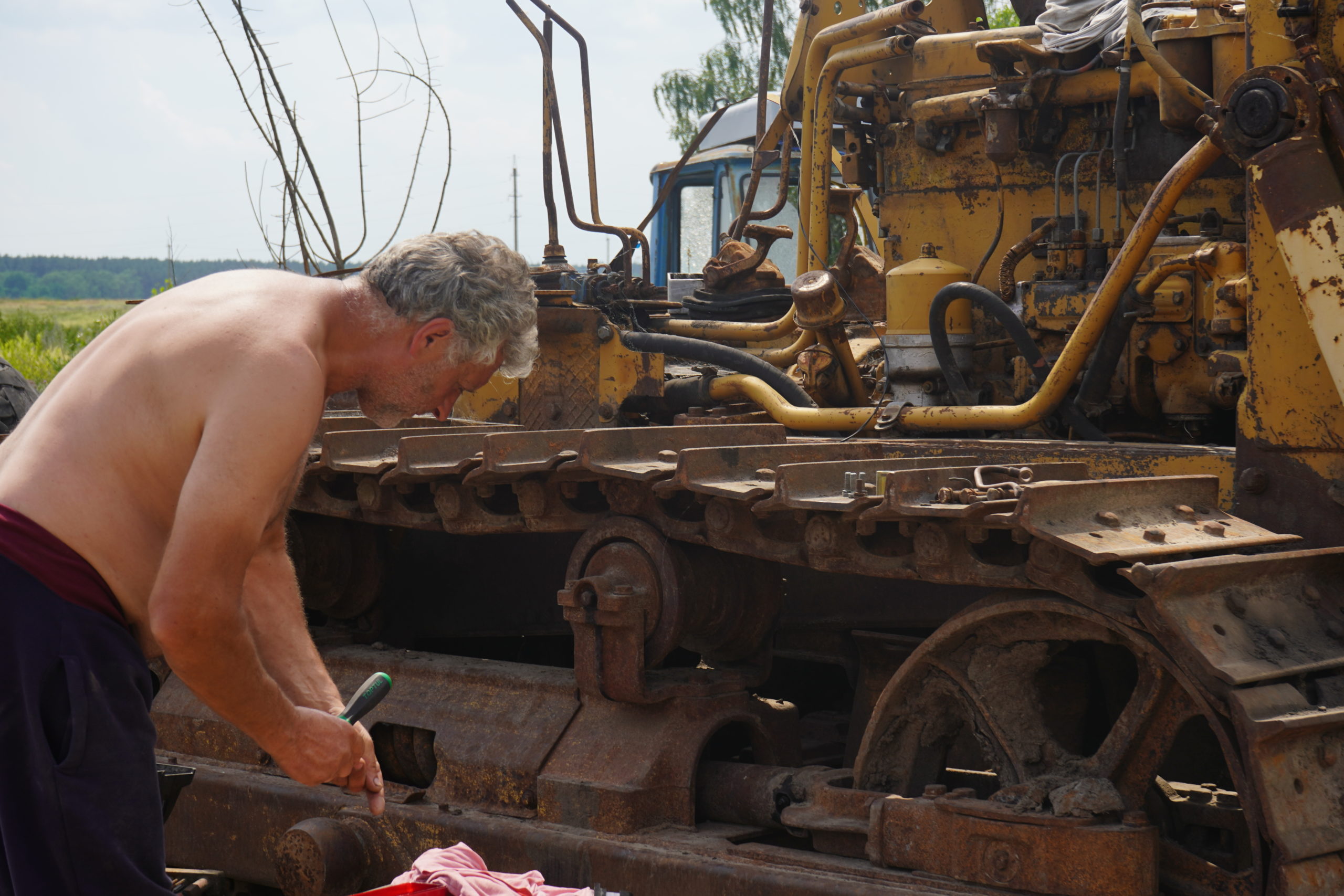
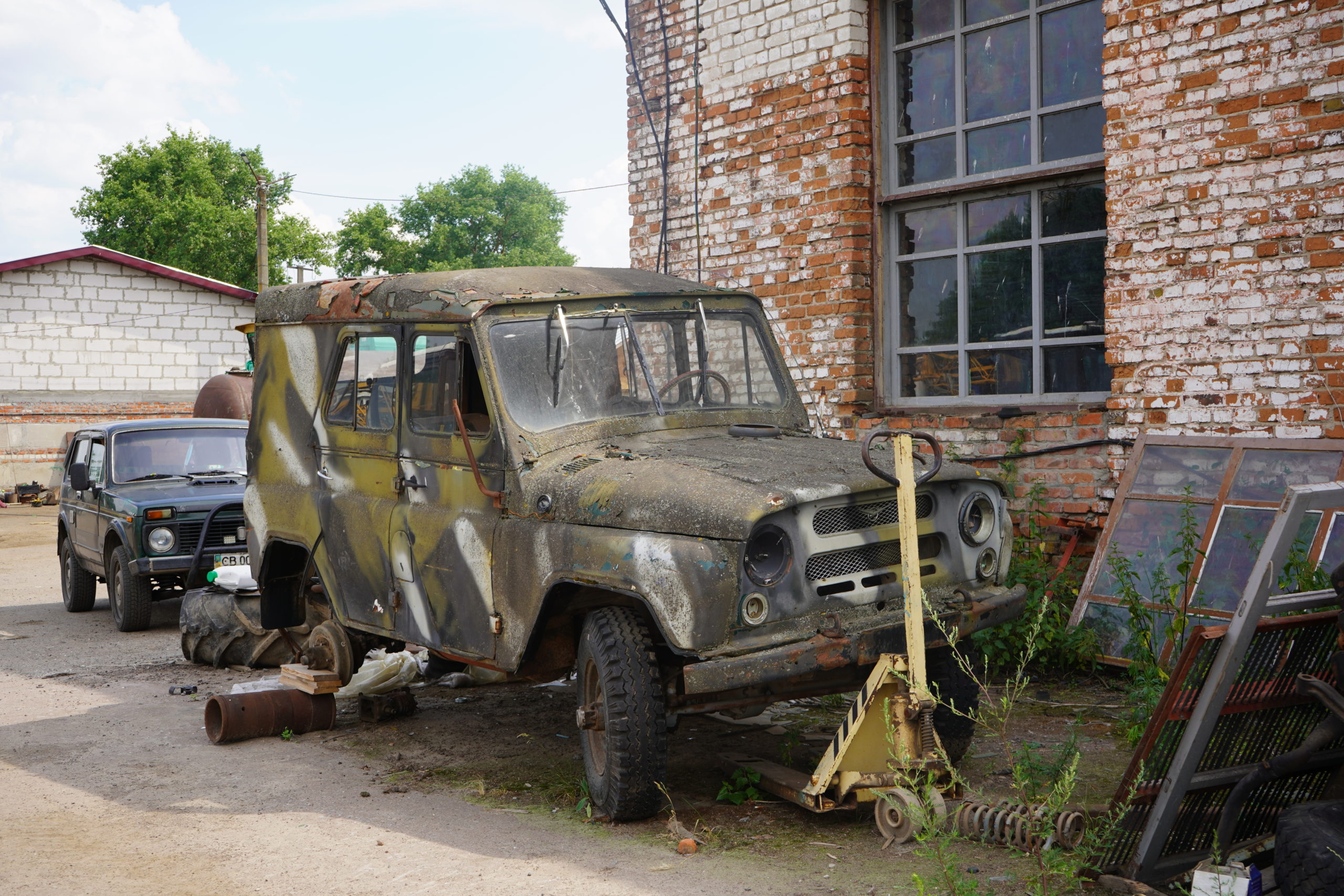





According to Serhiy, there was not a single surviving unit of agricultural machinery on the farm after the village was liberated:
“The Russians removed the starters, generators, batteries, pierced the tires, damaged the wiring. They poured all the diesel, and what remained was set on fire. They took some parts for their needs.”
A neighboring farm also experienced looting and destruction of equipment.
The full-scale Russian invasion caused at least UAH 10 million in damage to Serhiy’s family business, but he never made the final calculations:
“I had no time. I had to save the equipment.”
Despite the occupiers’ statements that the farmers would not sow this year, “Lan” enterprise carried out a sowing campaign in full.
The Russian military left a mined forest and fields in Shestovytsia.
On May 20, an agronomist fell victim to a landmine: his leg was torn off. Even a month after the liberation, local residents constantly heard explosions as experts were demining the territory and eliminating shells left by the Russians. Explosions are heard occasionally even now і .

